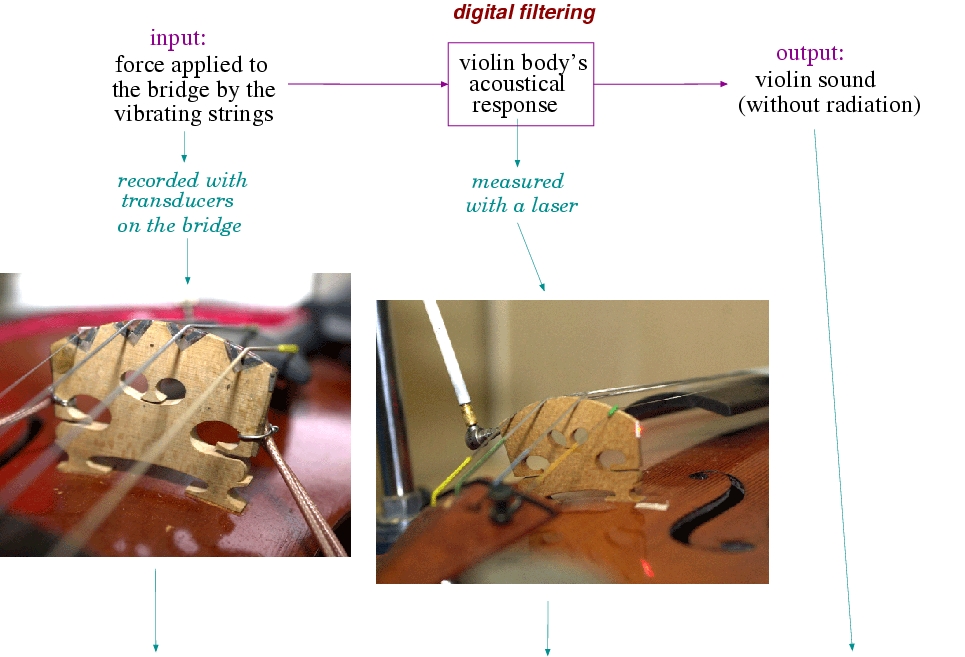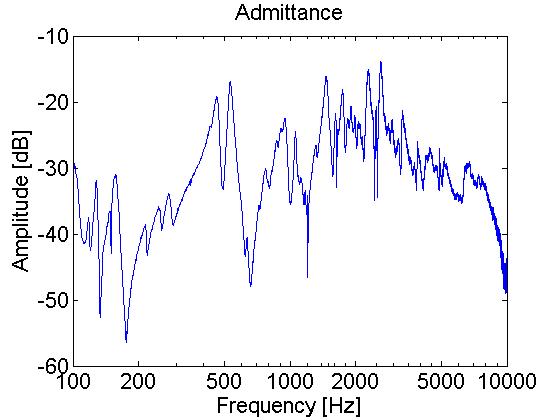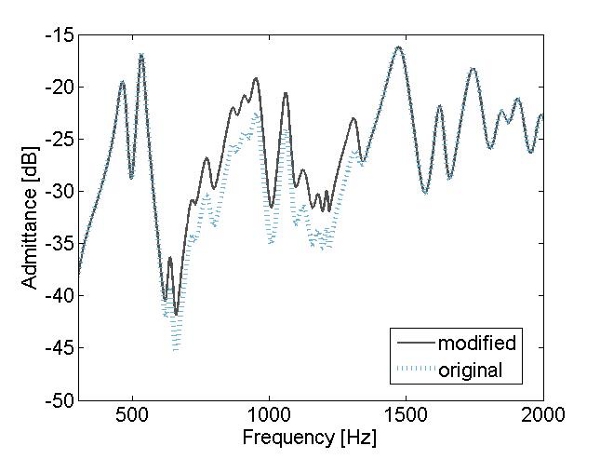Now Thats a Quality Instrument: How Violinists Evaluate Violins
Claudia Fritz - claudia.fritz@upmc.fr
Institut
Jean Le Rond dAlembert, UMR CNRS 7190
Universit
Pierre et Marie Curie,
4 place Jussieu, 75005
Paris, France
Popular
version of paper 2aMU5
Presented Tuesday
morning, April 20, 2010
159th ASA Meeting,
Baltimore, Maryland
Violins crafted
300 years ago by the master violin-maker Antonio Stradivari sell for millions
of dollars on the rare occasion they reach auction. What is it about their quality
that makes them prized above all others?
Science has not provided any convincing evidence for the existence of
any measurable property that would distinguish the Cremonese
instruments from the finest violins made by the best violin makers today. This
is, in part, due to the fact that science has mainly been focusing on the
violin but little to none on the violinist himself. Although centuries of
research have given us much information about the acoustics of the violin and
the way in which said acoustics are shaped by violin makers, virtually nothing
is known about how violinists evaluations of violins correlate with their
acoustical features. The aim of the project is therefore to better understand
how violinists evaluate violins: the most important thing is indeed not whether a
violinist likes this or that violin (or whether this violin is good or bad) but
rather understanding why he has come to this opinion. From this information, we can finally
correlate violinists evaluations with violins acoustical properties.
EXPLORING VIOLIN TIMBRE:
NASALITY AND CLARITY
The first step
of our research was to reduce the complexity of the problem to evaluations of
the violins sound only. Nothing was known about how human capacities for
perceiving, discriminating and judging violin sounds matched up to their
acoustical features. This is a very significant gap, as perceptual judgments
obviously define what makes a violin different from, say, a cello, just as it
makes one violin different from another, for listeners, performers and
violin-makers alike. A three-year
project funded by the Leverhulme Trust at the
University of Cambridge from 2005 to 2008 was intent on filling this gap. The
approach has involved collaboration between researchers from engineering, music, experimental
psychology and computer science (Jim Woodhouse, Ian Cross, Brian C.J. Moore, Alan
Blackwell and the author).
Virtual Violins
To carry out any
comparative study of musical instruments, it is important to rule out
variations caused by the player. Instead of achieving this by using a robotic
violinist that repeats the same piece on a variety of real violins, in this
project the violins themselves are virtual. The methodology of the virtual
violins, illustrated in figure 1, relies on the fact that the acoustical
behaviors of the strings and the violin body can be treated separately, and
that it is the latter that distinguishes different violins. In fact, on its
own, a string makes hardly any sound at all and its acoustical behavior is
rather similar from one instrument to another. The main acoustical feature that
colors the sound in ways that are unique for each violin is the manner in
which the violin body responds to string vibration transmitted to the bridge.
This characteristic transformation is known as the violins frequency
response.


Figure 1. Principle of the virtual violins
Sensors on a
violin bridge record the string waveforms arising as a player performs normally
on a real violin. This recording is played through computer models of
different violins frequency responses using digital filters. The frequency responses can be derived from
measurements made on a range of real violins. A prediction of the sound of the
violin can thus be created without having to worry about any complications
caused by variations in playing. Moreover, once the violin response is
represented in digital filter form, it becomes very easy to make controlled
variations of a kind that would be almost impossible to achieve by physical
changes to a violin.
Listening test
Based on his measurement of the acoustical properties
of a large range of violins that had previously been classified as of very good
or moderate quality, Dnnwald (1991) suggested four
important frequency bands in the frequency response for the judgment of sound
quality. In particular, he associated a large amplitude (of the violins reponse) in the band 650-1300 Hz with nasality and a low
amplitude in the band 4200-6400 Hz with clarity, but without any perceptual
testing. The virtual violins that were used in a listening test put these
assertions to the test. More
specifically virtual violins were created by modifying the amplitude of the
response of a baseline violin in 5 octave bands, from 200 Hz to 6400 Hz. An
example of a violin where octave band 3 (800 1600 Hz) was modified is given
in figure 2.

Figure 2. Frequency response of the original violin used as a
baseline and frequency response of a virtual violin corresponding to a
modification in amplitude of the original response in the third octave band
(800-1600 Hz)
The sound files for the listening tests were then
synthesized by playing a very short musical phrase through these virtual
violins.
The listening test was conducted with 14 English
native and 14 French native violinists. The participants had to choose, for 150 pairs of these modified violin
sounds, which sound was the most clear / clair or
nasal / nasal.
The results are very similar
for both languages and conflict with Dnnwalds
suggestions. The results for clear and clair yielded a high degree of consistency between subjects, and the term was associated with an increase
of energy in the frequency range 1.6 kHz to 3.2 kHz. For nasal, subjects could be divided into
two groups, each showing high consistency.
An increase in the band 1.6 kHz to 3.2 kHz increased nasality for the first group
while decreasing it for the second one.
Analysis of the musicians discourse
To go beyond the simple
labelling, the French participants were asked to give explicit descriptions of
what clair and nasal means for them and the
reasons of their choices, as suggested by Danile
Dubois, a cognitive psychologist with whom the author collaborates.
Linguistic analyses were thus conducted on the descriptions
given by the participants. For clair, two meanings
emerge: clair can characterize a sound which is
rich in high frequencies or a sound which is precise, definite, direct.
Regarding the consistency of the participants answers to the listening test,
both definitions seem to correlate with a higher amplitude of the harmonics in
the fourth octave band (1600-3200 Hz).
For nasal, the two groups obtained from the
listening test were semantically identified as corresponding to two meanings of
nasality. One refers to the quality of a twangy voice
or instruments like the bagpipes. This correlates with a large content of high
frequencies (group 1). The other meaning of nasal, less consensual, seems to
correspond to the phonetical nasality (vowels like
[],[]) and/or to the fact that the sounds appear cut or low-pass filtered,
and therefore correlates with a low content of high frequencies (group 2).
VIOLIN QUALITY EVALUATIONS
Exploring sound quality and how it correlates to
acoustical features can only tell part of the story, as a violin cannot be
reduced to its sound. Otherwise, listeners would be on par with violinists in
distinguishing between different instruments. One reason for this perceptive
gap is that a listener will only hear the result of the interaction between the
musician and the instrument. As a good musician will always try to get the
sound he likes, this will smooth out the differences between instruments for
the listener. A second reason is that
the player can evaluate what he gets from his violin and the sound he produces
in relation to what he gives to the violin. This feedback is most certainly
essential for evaluating the quality of a violin.
A first series of interviews was thus conducted in
order to better understand what makes a good violin. Three French professionals
at a soloist level were asked to describe what a good violin was for them. The
linguistic analysis of their answers gave straightforward and highly consistent
results: what makes a good violin is first a quick and good response, a good
projection and a large color range, and then, only then, its sound itself.
Sound quality will only matter if the violin sounds for instance too nasal or
too sharp. Otherwise, if there is no big defect, sound quality is not important
as the player will shape it the way he likes it. However, after informal discussions with
violin makers on this topic, it seems that this is not the case for amateur
violinists, for whom the timbre of the violin will be more important. More
interviews with violinists of different expertise need therefore to be
conducted.
In addition, more interviews are needed to understand
what are a good response, a good projection and a large color range. This will
help us to infer mechanical properties that may have not been considered until
now, in the acoustical studies which have been too much violin centered until
recently. More research in collaboration between acousticians, psychologists,
violin makers and high quality violinists will hopefully provide the keys to
characterize the properties of fine quality violins that are relevant and
important for violinists in meaningful physical terms that can eventually be
measured.